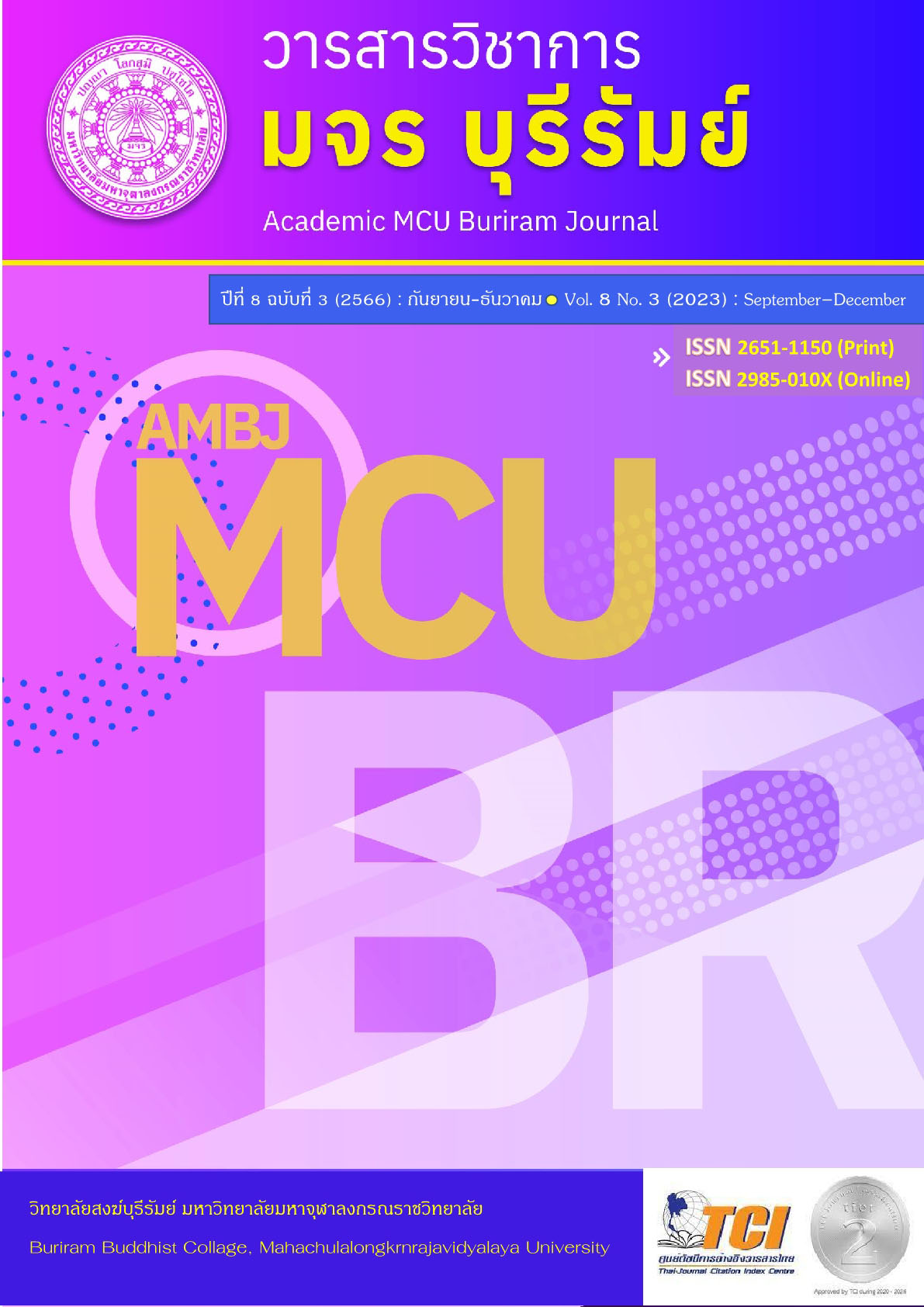The Results of Learning Management using Choice-Based Art Education on Visual Elements towards Critical Thinking Skills to Create Works of Mathayom Suksa 1 Students
Keywords:
Learning Management, Choice-Based Art Education Learning, Critical Thinking, Creative ArtsAbstract
The purposes of this research were: 1) to develop a visual elements unit learning plan using Art Education Choice-Based learning on critical thinking skills to create works of secondary 1st students with an efficiency of 80/80, 2) to compare the critical thinking skills to create works of students before and after learning, and 3) to study the satisfaction level of secondary 1st students toward the visual elements unit learning plan using Art Education Choice-Based learning on critical thinking skills to create works developed by the researcher. The sample was 25 secondary 1st students of Ratchaprachanukroh 29 School, Sisaket Province, which was obtained from a cluster random sampling using the classroom as a random unit. The research tools consisted of 1) a visual elements unit learning plan using Art Education Choice-Based learning 2) an assessment form of critical thinking skill to creating works, and 3) a questionnaire on students' satisfaction towards the visual elements unit learning plan using Art Education Choice-Based learning. Data analysis included the percentage, mean, Standard deviation, and t-test.
The research results found that:
1. The effectiveness of the visual elements unit learning plan using Art Education Choice-Based learning on critical thinking skills to create works by secondary 1st students (E1/E2) was 71/80, which did not meet the set threshold.
2. The comparative result of the critical thinking skills to create works of secondary 1st students after learning was significantly higher than before learning at the 0.05 level.
3. The students' satisfaction towards the visual elements unit learning plan using Art Education Choice-Based learning was very high, with an average of 4.44 and a standard deviation of 0.75.
References
กรกนก เลิศเดชาภัทร, ชาตรี ฝ่ายคําตา และจีระวรรณ เกษสิงห์. (2565). การประเมินทักษะการคิดอย่างมีวิจารณญาณของนักเรียนมัธยมศึกษาตอนต้น. วารสารศึกษาศาสตร์ มหาวิทยาลัยนเรศวร, 24(1), 56-65.
ฐิติกานต์ แก้ววิเศษ. (2565). การพัฒนาแนวการจัดการเรียนรู้วิชาภาษาไทยแบบเชิงรุกโดยใช้วรรณคดีเป็นฐานเพื่อส่งเสริมความสามารถของผู้เรียนในศตวรรษที่ 21 สำหรับนักเรียนระดับชั้นมัธยมศึกษาปีที่ 1. วารสารวิชาการและวิจัยสังคมศาสตร์, 17(3), 67-80.
ณชนก หล่อสมบูรณ์ และโสมฉาย บุญญานันต์. (2563). ผลการจัดการเรียนรู้ศิลปศึกษาบนฐานทางเลือกที่มีต่อทักษะการคิดอย่างมีวิจารณญาณในการสร้างสรรค์ผลงานของนักเรียนชั้นประถมศึกษาปีที่ 4. วารสารครุศาสตร์ จุฬาลงกรณ์มหาวิทยาลัย, 48(4), 166-181.
ดนิตา ดวงวิไล, สุขิริณณ์ อามาตย์บัณฑิต และอัฐพล อินต๊ะเสนา. (2562). การพัฒนาหลักสูตรสาระเพิ่มเติมเพื่อเสริมสร้างสมรรถนะด้านการคิดวิเคราะห์ของนักเรียนระดับประถมศึกษา สังกัดกลุ่มศูนย์พัฒนาคุณภาพการศึกษา ท่าสองคอน-แก่งเลิงจาน. วารสารศึกษาศาสตร์ มหาวิทยาลัยนเรศวร, 21(1), 75-92.
ภัณฑิรา ศรีใจ และสมบัติ ท้ายเรือคำ. (2565). การพัฒนากิจกรรมการเรียนรู้คณิตศาสตร์เพื่อส่งเสริมความรู้สึกเชิงจำนวน สำหรับนักเรียนชั้นประถมศึกษา. วารสารวิชาการและวิจัยสังคมศาสตร์, 17(2), 199-212.
โรงเรียนราชประชานุเคราะห์ 29 จังหวัดศรีสะเกษ. (2565). รายชื่อนักศึกษาระดับชั้นมัธยมศึกษาปีที่ 1. โรงเรียนราชประชานุเคราะห์ 29 จังหวัดศรีสะเกษ. อัดสำเนา.
ศิริชัย กาญจนวาสี, ดิเรก ศรีสุโข และทวีวัฒน์ ปิตยานนท์. (2535). การเลือกใช้สถิติที่เหมาะสมสำหรับการวิจัยทางสังคมศาสตร์. กรุงเทพฯ: จุฬาลงกรณ์มหาวิทยาลัย.
สำนักงานคณะกรรมการการศึกษาขั้นพื้นฐาน กระทรวงศึกษาธิการ. (2551). ตัวชี้วัดและสาระการเรียนรู้แกนกลาง กลุ่มสาระการเรียนรู้ศิลปะ ตามหลักสูตรแกนกลางการศึกษาขั้นพื้นฐาน พุทธศักราช 2551. กรุงเทพฯ: ชุมนุมสหกรณ์การเกษตรแห่งประเทศไทย.
สุนทรี ทมกระโทก และศิริพงษ์ เพียศิริ. (2563). ผลการจัดการเรียนรู้วิชาศิลปะ เรื่อง ศิลป์สร้างสรรค์จากวัสดุธรรมชาติ โดยใช้รูปแบบการเรียนรู้ 5Es ร่วมกับเทคนิคการสอนโดยใช้เกมของนักเรียนชั้นประถมศึกษาปีที่ 3. วารสารบัณฑิตศึกษา, 17(79), 151-157.
สุริตา ทองขาว. (2565). การพัฒนาชุดฝึกทักษะการอ่านสะกดคำ กลุ่มสาระการเรียนรู้ภาษาไทย สำหรับนักเรียนชั้นมัธยมศึกษาปีที่ 1 ที่มีปัญหาการอ่านสะกดคำ. สารนิพนธ์ปริญญาศึกษาศาสตรมหาบัณฑิต สาขาวิชาหลักสูตรและการสอน. บัณฑิตวิทยาลัย: มหาวิทยาลัยราชธานี.
อุษณีย์ อนุรุทธ์วงศ์. (2555). ทักษะการคิด: พัฒนาอย่างไร. กรุงเทพฯ: อินทร์ณน.
Douglas, K., & Jaquith, D. (2018). Engaging Learners through Artmaking: Choice-Based Art Education in the Classroom (TAB). Second Edition. Retrieved from https://eric.ed.gov/?id=ED581779 (Accessed 12 February 2023).
Joo, Y. (2014). Teaching Strategies for implementing Choice-Based Art Curriculum. Retrieved from https://scholarworks.gsu.edu/cgi/viewcontent. cgi?article=1179&context=art_design_theses (Accessed 12 February 2023).
Downloads
Published
How to Cite
Issue
Section
License
Copyright (c) 2023 Academic MCU Buriram Journal

This work is licensed under a Creative Commons Attribution-NonCommercial-NoDerivatives 4.0 International License.
ทัศนะและความคิดเห็นที่ปรากฏในบทความวารสารฉบับนี้ถือเป็นความรับผิดชอบของผู้เขียนบทความนั้น ไม่ถือเป็นทัศนะและความรับผิดชอบของบรรณาธิการ





